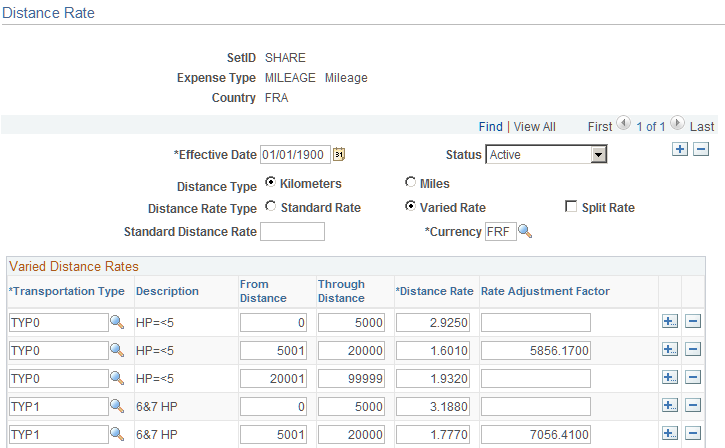Setting Up Distance Rates
To set up distance rates, use the Distance Rate (EX_AUTO_RT_TBL.GBL) component. Use the EX_AUTO_RATE_SETUP component interface to load data into the table for this component.
|
Page Name |
Definition Name |
Usage |
|---|---|---|
|
EX_AUTO_RT_TBL |
Define distance rates for various base countries, with each combination tied to an expense type. |
Use the Distance Rate page (EX_AUTO_RT_TBL) to define distance rates for various base countries, with each combination tied to an expense type.
Navigation:
This example illustrates the fields and controls on the Distance Rate page. You can find definitions for the fields and controls later on this page.

Before you can establish a distance rate, you must:
Create an expense type (such as Mileage) to which the distance rate is applied.
Select an expense type edit of Automobile for the expense type.
Field or Control |
Description |
|---|---|
Distance Type |
Select either Kilometers or Miles. |
Distance Rate Type |
Select Standard Rate when mileage reimbursement is not dependent on miles or kilometers traveled. If selected, PeopleSoft Expenses uses the Standard Distance Rate field to determine reimbursement. Select Varied Rate to have PeopleSoft Expenses determine reimbursement based on the distance traveled by the employee for a particular transportation type. |
Split Rate |
Select Split Rate to have PeopleSoft Expenses calculate reimbursement based on the distance that falls in each row in the Varied Distance Rates grid when the distance that is traveled spans multiple distance rate rows. In other words, PeopleSoft Expenses can take one distance traveled amount and apply two different rates to calculate a reimbursement amount. If Split Rate is not selected, and the accumulated distance spans multiple distance rate rows, PeopleSoft Expenses uses the rate that is in the highest distance rate row in the Varied Distance Rate grid to calculate the entire reimbursable amount. For example: Kilometers 0 through 5,000 has a distance rate of 2.925 EUR; kilometers 5,001 through 20,000 has a distance rate of 1.601 EUR. The accumulated miles are 4,925, and you travel 100 kilometers. If Split Rate is selected, PeopleSoft Expenses calculates 75 kilometers at 2.925 EUR and 25 kilometers at 1.601 EUR. If Split Rate is not selected, PeopleSoft Expenses calculates 100 kilometers at 1.601 EUR. Note: The Split Rate check box is only available if you select Varied Rate for the distance rate type. |
Standard Distance Rate |
If the Distance Rate Type is Standard Rate, indicate the monetary amount to reimburse per unit that is driven. |
Currency |
Enter a currency to use for the distance rate. If the employee's base currency is different from the currency that is on the Distance Rate page, Expenses converts the amount to the employee's base currency. |
Varied Distance Rates
Field or Control |
Description |
|---|---|
Transportation Type |
Designate modes of transportation that employees use. For instance, in many countries, mileage is reimbursed based on the horsepower of the car that is driven, so the transportation types would be 3HP, 4HP, and so on. |
From Distance and Through Distance |
Enter the beginning or end of a range in which an employee is reimbursed a particular distance rate. The range is for cumulative mileage that is driven by an employee in a calendar year. |
Distance Rate |
Enter the rate at which to reimburse an employee within the specified range. |
Rate Adjustment Factor |
Enter a rate to create a sliding scale for auto mileage reimbursement. This factor is used in the formula to determine the mileage rate reimbursement, which is based on distance rate and distance that is accumulated (in miles or kilometers) that an employee travels in a calendar year. The rate adjustment factor is used in countries such as France and Belgium. The rate that results is determined by this formula: Adjusted Distance Rate = (( Distance Rate * Total Distance) + Rate Adjustment Factor) / Total Distance) |